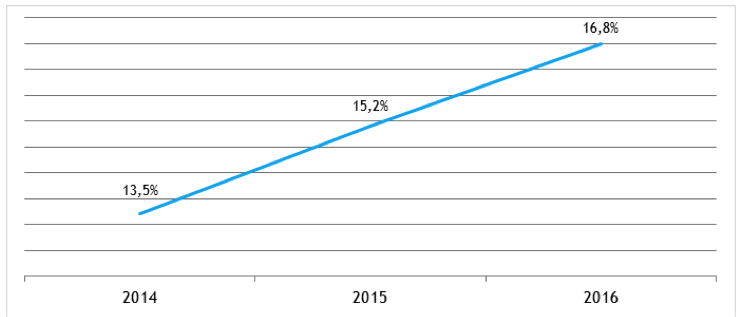Fine gems and jewellery enter the digital age
The fine gems and jewellery industry has been slow to embrace the digital age and the current e-commerce share of this market stands at a mere 5%. However, in the view of Forbes and many other expert commentators, this market share is set to double by 2020. In April 2016 Tiffany & Co chose Net-A-Porter as their exclusive e-commerce partner. This expanded Tiffany’s e-commerce presence from just 13 countries to more than 170. In the words of Forbes, “the partnership exemplifies a broader trend in jewelry retail: fine jewelry retailers are finally getting online.” (Forbes.com, April 2016). The omens are bad for gem dealers and jewellers who think they can buck this online trend, yet many small independent retailers do not even have a basic website!

More broadly the global fine jewellery market is expanding apace. Global sales totalled $314.6 billion in 2015, forecast to rise to $410 billion by 2020, an increase of 30.32%. (Luxury Daily, July 2016). Much of the growth has been driven by the emerging markets, notably China, the Middle East and, to some extent, India but more recently North America and Europe have showed signs of growth as well. Very few of the players in this market have a truly global coverage in terms of their retail stores so e-commerce certainly has a valuable role in terms of reach for all market participants but especially for the medium sized and smaller players.

The relevance of these industry trends to retailers and stakeholders was highlighted recently by a market report by research company L2, published in Luxury Daily: “A high digital IQ is important in all luxury sectors because ecommerce and mobile commerce are growing much quicker than in-store revenue. Brands can learn from Cartier, Tiffany & Co. and Bvlgari, who not only have attractive and frequent social media communication but also a refined modern Web site and customer service that leaves the customers well-informed and satisfied.” (Luxury Daily, July 2016). The L2 report went on to state: “many brands continue to under-invest in their e-commerce capabilities, especially in European markets, allowing competitors and grey market retailers to win market share.”

A good example of the growth of the digital space as a whole is the experience of the UK e-commerce retail market in recent years. The graph above states the overall retail market share of e-shopping and it clearly shows the direction of travel. In Britain today, £1 in every £6 of retail spend is transacted online. If one considers the money spent on purchases that were initiated by online activity, such as a product or company found on a Google search, this figure is vastly increased! Fine jewellery and gems are ‘catching’ up and there are generational forces at play. The ‘millennials’ are now entering their 20’s and 30’s, they are tech savvy, used to purchasing a range of products online and their incomes are steadily increasing. The graph below illustrates the response to this trend in terms of overall allocation of marketing spend. It is no exaggeration to suggest the likely continuation of the trends shown below and above into the foreseeable future.
Digital Advertising spend as a percentage of overall advertising spend:

Perhaps surprisingly, many high end luxury brands have been slow to embrace social media as an advertising and brand recognition vehicle, Chanel only launched their Instagram page in January 2016! Most have come to accept the importance of social media but not all have managed to get it right. The most important factor determining success with social media is engagement, not simply the number of ‘likes’ or ‘followers’ a page or post receives. Celebrity endorsement has lead to a great deal of success for some brands. Louis Vuitton and Dior have been chief among these, featuring celebs wearing their branded items at ‘A-list’ red carpet events. Many pages have focussed on behind the scenes insights and ‘raw’ images in order to stand out from the vast crowd that has now gathered around this medium. Their logos are instantly recognisable and highly sort after.



Instagram Official page Logos for Chanel, Louis Vuitton and Dior
Despite the advances in technology, a traditional customer focus is still a key ingredient with any successful brand and this is no less true than in the fine gem and jewellery industry. This was best described recently by Ambika Zutshi, CEO of Fashionbi, a leading data and insights provider in the fashion and luxury industry:
“This market is still very fragmented, which means there isn’t one top-of-the-mind player for the customers. They explore their options very well before investing in such high-end products and hence, the brands with the best offers and services in that moment will be able to attract these customers.” Many brands “still don’t have ecommerce services, special social media communication, global shipping options, receptive customer services or global distribution. As a result, many customer can’t reach or even inquire about the products. Hence, a big opportunity for the brands is to invest in digital.”

In conclusion, the gem and fine jewellery industry has been slow to embrace the digital revolution. However, many of the key industry players are now starting to engage with e-commerce and social media enthusiastically. This new technology allows smaller participants to play a role in the market on, almost, equal terms with their larger and wealthier rivals. Due to the fact that the industry is so far behind the digital curve of most retail sectors, the growth in online shopping over the coming years is likely to be even more pronounced, in fact it is forecast to double in market share over the final years of this decade! The UK is a clear example of the growth of e-commerce retail overall and this is having a profound effect upon the way in which shoppers interact with their shops! Finally social media has yet again demonstrated its profound effect on the brand building potential of the major market participants, enabling them to engage with their customers and potential customers in new and innovative ways.
Visit London DE’s blog to explore similar articles.


